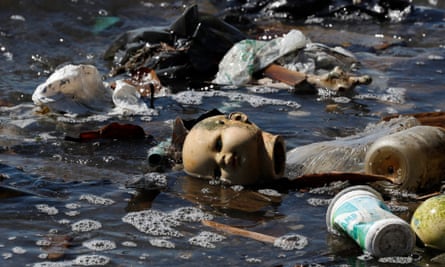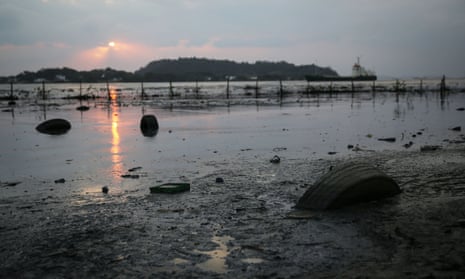There can be few more beautiful city sights in the world than that from the Marina da Gloria, where the Rio 2016 Olympic sailing events will be launched this weekend.
Look out from the quayside across Guanabara Bay and the panorama takes in Sugarloaf mountain, the Niteroi bridge and the distant hills of the Serra dos Orgãos national park, while behind you are the palm trees of Flamengo Park and the statue of Christ the Redeemer.
But this treat for the eyes – which will make it the perfect backdrop for TV sports broadcasts – is sometimes so polluted with untreated human waste that it can also be an assault on the nose and the immune system, prompting a recommendation from the United Nations that competitors and spectators should spend as little time in the water as possible.
In its latest advice, the World Health Organisation said: “It is suggested that all athletes should cover cuts and grazes with waterproof plasters prior to exposure, try to avoid swallowing the water, wash/shower as soon as possible after exposure and, as far as possible, minimise their time in the water and avoid going in the water after heavy rainfall if possible.”
Many locals, however, ask why it has taken hosting the Olympics for city authorities take notice of a problem that they have had to live with for more than a decade.
“The water quality is shit because the sewage flushes in untreated. We all know that. No local would swim in it because we know we would get a disease,” said Alex Batista, a skateboard instructor who teaches on the Aterro do Flamengo, an area of reclaimed land between the bay and the city centre.
That popular wisdom has been reinforced by a series of studies in the past year, which suggest that Guanabara Bay – and other aquatic venues the Rodrigo de Freitas Lagoa (rowing and canoeing) and Copacabana beach (triathlon and open water swimming) – are teeming with pathogens.
The Associated Press reported levels of bacteria and viruses so high that swallowing just three teaspoons of water from the bay was likely to lead to severe stomach and respiratory illnesses. Concentrations of adenoviruses were said to be thousands of times higher than the levels considered safe in the US or Europe.
Leading UK medical journal the Lancet has warned that the risk to the health of athletes was “of concern”. In an editorial last year it said: “Nearly 1,400 of the more than 10,000 athletes competing at the Games will be directly exposed to the contaminants in this water.

Amid a slew of alarming headlines, some athletes have been pre-emptively taking antibiotics, bleaching their oars and training in protective suits.
But Maria Neira, the WHO’s director of Public Health and Environment, which has been advising the Olympic committee , played down fears of dangerous levels of pollution, saying the risk of illness has been minimised “as far as possible”.
“If there is a risk, it will be for mild intestinal problems leading to diarrhoea. The athletes will be healthy, so for them the risk may be less than for normal populations,” she told the Guardian.
Nonetheless, UN monitoring has revealed water quality in Guanabara bay and the marina area that WHO guidelines categorise as poor or very poor.
Cycling along the bayside on Tuesday, it was not hard to see why. Channels near Botafogo and Flamengo discharged foul-smelling murky waters that were supposed to have been treated. On the beach, there were hundreds of people sunbathing, playing volleyball, drinking beer and chatting – but very few who ventured into the waters.
“It’s very dirty,” said Tais Montero, a student who lives nearby. “I only have a dip in extreme circumstances – if it is very hot and the shower is not working.”
Further along the coast, retiree Anibal Rodrigues was fishing on some rocks and lamenting his poor luck. He had caught just one small fish in an hour, but he said 20 years ago it would have been six or seven. “The pollution has got worse. The fish don’t like that.”
Nonetheless, in this part of the bay, the water looked and smelled much cleaner and there was little floating rubbish beyond a couple of plastic bottles. Certainly, the wildlife had not yet given up, proven by a small turtle that swam by.
The worst affected areas are further to the north of the city, where low-income favela communities are concentrated and government investment in water systems and sewage treatment is inadequate.
As part of its Olympic bid, the state of Rio de Janeiro committed to expand and upgrade the system so that 80% of sewage is treated. There has been progress but it has fallen far short of this goal.
Since 2009, the state-run water company CEDAE claims to have spent more than £500m on tripling sewage treatment in the bay, but still less covers less than half of residents.
The city mayor, Eduardo Paes, has lamented the state government’s failure to clean up Guanabara Bay, but he said the Olympics had brought improvements in some areas.
“Our pollution reduction efforts have been successful in that Olympic sailing events will take place on the bay, close to the mouth where it is cleanest. The process of preparing for the Games has brought attention to the issues of pollution, waste management and water usage.”
Alberto Chebabo, an expert on infectious diseases at Rio’s Federal University hospital, agreed that the risks varied around the bay. At the northern end, he said waters were not remotely suitable for swimming, but nearer the mouth – where the sailing events will be concentrated – he said the bay was relatively clean.
In any case, he said sailors who have been training here over the past year are likely to have built up antibodies against many of the viruses in the water. However, he and other experts caution that weather is also a key factor. If it rains, far more sewage and rubbish flows into the bay and a much wider area is polluted.
At the marina on Tuesday, competitors appeared to have resigned themselves to the situation and would rather focus on the event. “We sailors don’t talk about this among ourselves. It’s not a big issue for us. I think the problems have been exaggerated in the media,” said Sofian Bouvet, a member of the French sailing team.
“This bay is a great place to sail. I have trained here 11 times and I have never become sick. It’s a fact that the water isn’t clean, but it is not surprising for a city of this size. These problems existed for many years. Why is it only now that people talk about them?”

Neira said water quality varied from one site to another. “The data we are seeing suggests that water quality is within WHO guidelines off Copacabana beach where athletes will be swimming and highly exposed. The risk of illness at sites near theMarina da Glória and Rodrigo de Freitas Lagoon where they are not swimming is very limited”.
In new advice, the UN said that monitoring showed that some sites failed to meet Brazilian water quality standards and would be classed under WHO guidelines as poor or very poor. “In Guanabara Bay and the marina areas there have been poor quality results but they are starting to come into compliance,” said Neira.
Water quality is likely to vary throughout the day depending on sunshine and rainfall, but organisers will inspect tall sites and receive data allowing them to cancel competitions if pollution levels are too high.
Athletes competing in aquatic events should be familiar with the risks of water-borne infections: only five years ago former British Olympic rower Andy Holmes died from Weil’s syndrome caused by infection with leptospira caught from the fresh water of Lincolnshire in England.
Mayor Paes said the water pollution had improved. “I welcome this scrutiny because it is generating a debate that will benefit the city – and the country – for decades to come. Guanabara Bay is not yet the pristine body of water we hope it will be one day, [but] it is far cleaner today than at the start of the bid process.”
As part of its Olympic bid, the state of Rio de Janeiro committed to install sewers and water treatment facilities in 80% of communities ahead of the Games. But progress has been very slow and this goal is not even coming close to being achieved.
According to the city authorities, nearly 70% of the residents living in the Guanabara Bay watershed still lack basic sewage treatment and the large number of people living in favelas (“slums”) makes it extremely difficult to bring in sewer lines.

Comments (…)
Sign in or create your Guardian account to join the discussion